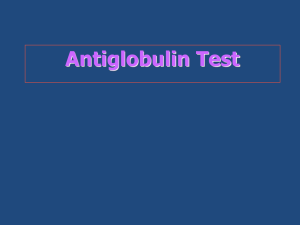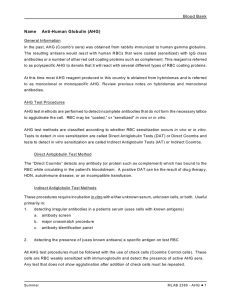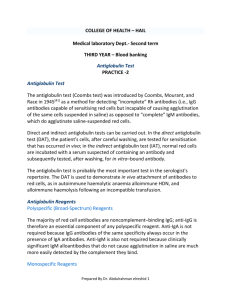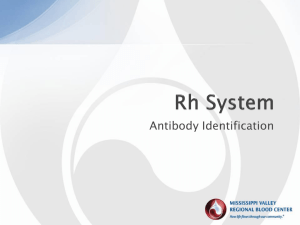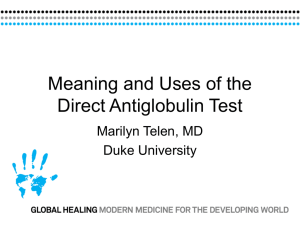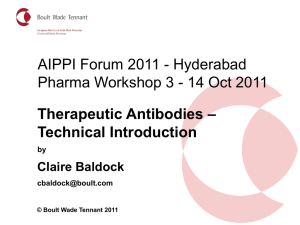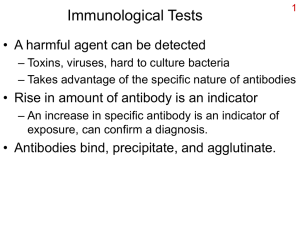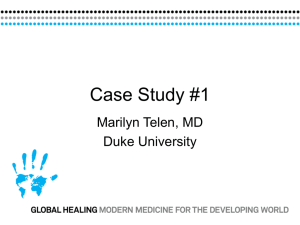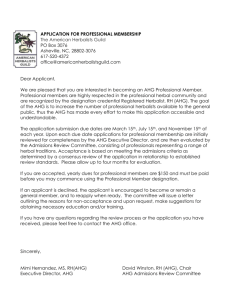The Antiglobulin Test
advertisement
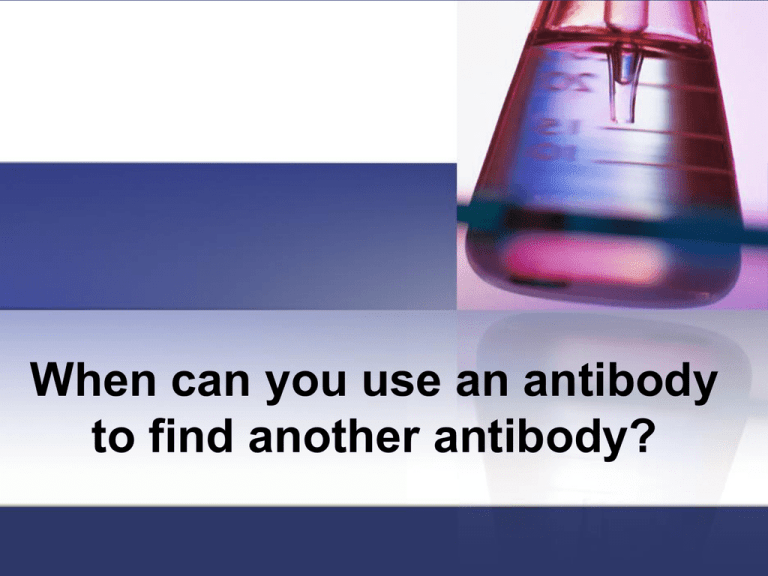
When can you use an antibody to find another antibody? The Antiglobulin Test Basic Principle, Procedures, and Applications The Acquired Immune Response From our Immunology Review we know: The body makes antibodies in response to foreign antigen. These antibodies coat the foreign object leading to: Clearance of the foreign antigen by the RES Lysis of the foreign object via complement activation IgG is the predominant antibody produced in most responses Incomplete antibody Usually not detected at room temperature/immediate spin phase of testing The Antiglobulin Test The purpose of the antiglobulin test is to detect cells that have become coated with antibodies &/or complement. The test is also known as the Coombs test. Anti-Human Globulin The main reagent used in the antiglobulin test is anti-human globulin (AHG). Also called Coombs serum. Anti-human globulin (AHG) is an IgG antibody directed against human immunoglobulins or complement components. AHG Production AHG Production The globulins that AHG may be directed against include: IgG IgM IgA C3 AHG Contents Polyspecific AHG reagent contains antibodies to both IgG and C3. Monospecific AHG contains antibodies to either IgG or C3. AHG Action AHG combines with the Fc portion of a sensitizing antibody. This completes the antigen-antibody bridge, allowing agglutination to occur. Y When used to detect clinically significant antibodies, AHG reagent MUST contain anti-IgG. Control ANYTIME YOU ARE USING AHG REAGENT, AND GET A NEGATIVE TEST RESULT (by tube)--- YOU MUST ADD COOMBS CONTROL CELLS AND GET POSITIVE RESULTS!!! Coombs Control Cells Rh positive cells coated with anti-D antibodies or cells coated with the C3 portion of complement. Coombs Control Cells will react with the antibody in the AHG reagent. D D D D D D Y Coombs Control Cells will prove that… Coombs reagent was added. Coombs reagent was active. The wash step was adequate to remove any unbound globulins. The most common error made when performing the antiglobulin test is inadequate washing. Procedures Direct Antiglobulin Test (DAT) Detects antibody (or complement) sensitizing red cells In vivo sensitization Uses patient’s cells Procedures Indirect Antiglobulin Test (IAT) Antibody is free Uses incubation at 37oC to force red cell sensitization in vitro. May be used to detect antigens or antibodies. Both DAT and IAT utilize Anti-Human Globulin reagent (AHG). The Direct Antiglobulin Test Procedure Steps to the DAT Procedure (tube method) 1. One drop of patient’s red cells are washed with 0.9% NaCl a minimum of 3 times to remove plasma that may contain unbound antibodies. 2. AHG reagent is added. 3. Tube is centrifuged. 4. If IgG or C3 is coating the cells, agglutination will occur (positive test). This will depend on the type of AHG reagent used i.e. if C3 is coating the cell, and monospecific anti-IgG AHG reagent is used, there will be NO agglutination. If neither is present there will be no agglutination (negative test). 5. Each negative test is validated (controlled) through the addition of Coombs Control Cells (also called check cells). DAT Procedure (tube method) Pt ID √ Washed cell button The Direct Antiglobulin Test Applications What causes a cell to become coated with antibodies in vivo? Hemolytic Transfusion Reaction Hemolytic Disease of the Fetus and Newborn Drugs Disease Indirect Antiglobulin Test Procedure Steps to the IAT Procedure (tube method) 1. 2. 3. 4. 5. 6. One or two drops of serum (may contain an antibody) are added to a test tube. One drop of red cells (antigen source) is added to the tube. The tube is incubated at 37oC. The length of incubation is dependant on the medium. Following incubation, the cells are washed with saline a minimum of 3 times, to remove any unbound antibody. Following the final wash, two drops of AHG reagent are added to the dry cell button. The tube is centrifuged and results are read. The tube may be read microscopically, depending on the test medium. Coombs control cells are added to each negative test. The tubes are centrifuged and results read. Indirect Antiglobulin Test Tube Method 3 7 C i n c √ Indirect Antiglobulin Test Antibodies sensitize the red cells during incubation at 37oC. Following the wash step, AHG reagent is added. AHG reagent completes the “bridge” between red cells, allowing for visible agglutination. Indirect Antiglobulin Test Applications Indirect Antiglobulin Test Looking for in vitro cell sensitization. Uses incubation at 37oC to allow antibody to sensitize red cell. Uses AHG reagent to complete the “bridging” between red cells. Visible agglutination as a positive endpoint. Enhancement reagents may be added during incubation phase to increase sensitization and agglutination. Applications Using Patient’s Serum Antibody screen Detects antibodies in patient’s serum Uses reagent red cells as a source of known antigen Antibody panel Identifies antibodies Uses reagent red cells as a source of known antigen Applications Using Patient’s Serum Antiglobulin crossmatch Determines patient’s compatibility with donor Uses donor red cells (antigens) and patient’s serum (antibodies) Usually performed only when a patient has an antibody or a history of antibodies Applications Using Patient’s Cells Antigen Typing Weak D test Both use commercial anti-serum which contains antibodies, versus the patient’s cells (antigen). Auto control – Patient’s plasma vs. patient’s cells NOTE: If the patient has a positive DAT, the results of any IAT using the patient’s cells will be invalid. Cells are already coated with antibody before the incubation step! Factors affecting the IAT Serum/Cell ratio Incubation temperature pH Length of incubation Test environment (enhancement media) POTENTIATORS Some incomplete antibodies will not react in a saline environment. Potentiators are reagents that adjust the test environment. Reduce the zeta potential Promote agglutination Enhance antibody uptake 22% Albumin Polyethylene glycol (PEG) : a low ionic strength medium. Removes water from the test system, thereby concentrating any antibody present. LISS Enzymes Sources of Error in the Antiglobulin Test Adequate wash Centrifugation Problems with reagents/saline Problems reading reactions
